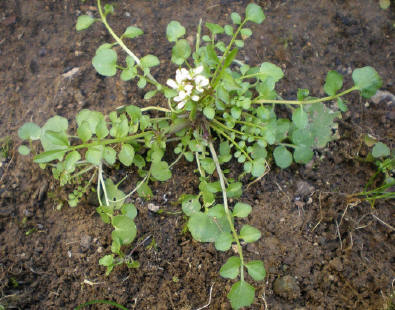Betty Jakum
Adams County Master Gardener
 It was early last spring when I noticed a new weed that had sprouted along a garden fence. The ordinary weeds of early spring were there, chickweed, purple deadnettle, ground ivy, but this weed was one I hadn’t seen before. It was a pretty little thing with its compact, low-growing basal form and slender stems sporting tiny white flowers. It had a dainty almost innocent appearance that made me wonder if I shouldn’t just let it grow. Little did I know what it was I was unleashing.
It was early last spring when I noticed a new weed that had sprouted along a garden fence. The ordinary weeds of early spring were there, chickweed, purple deadnettle, ground ivy, but this weed was one I hadn’t seen before. It was a pretty little thing with its compact, low-growing basal form and slender stems sporting tiny white flowers. It had a dainty almost innocent appearance that made me wonder if I shouldn’t just let it grow. Little did I know what it was I was unleashing.
This year I noticed these weeds again, only this time they seemed to be everywhere. My flower and vegetable gardens were full of them. They were growing in lawns, in fallow farmers’ fields, their white flowers blooming and setting seeds. This rapid spread was alarming enough to send me scurrying to find out what was going on.
It wasn’t long before I learned what I was seeing is a weed called Hairy Bittercress (Cardamine hirsuta). It belongs to a class of weeds called winter annuals that germinate in late fall and bloom in early spring. It also continues growing in its vegetative state during warm spells through the winter.
It loves wet, disturbed soil, the kind that is common in yards, gardens and paved areas. It’s happy in full sun as well as shade. It can also be found around the margins of springs, streams, and other naturally damp and rich areas. This weed is very noticeable in early spring during its peak flowering season; however, it becomes less conspicuous after stems are removed by mowing and as other vegetation takes hold. When the flowers are finished, the petals fall away, leaving green seed pods.
Hairy Bittercress, a member of the mustard family (Cruciferae), has leaves that emanate from a basal rosette which is more noticeable on young plants before larger leaves obscure the base. Its tiny white flowers form at the end on a single smooth red or green stalk sprouting from the middle of the plant. Each flower has four white petals that form in the shape of a cross. After flowering, the seed pods, or siliques, appear and turn from green to brown as they dry out. Eventually the pods "explode" using a technique called Ballochory, a kind of "ballistic dispersal" which flings seeds in every direction up to 16 feet or so away from the mother plant. Each plant has the ability to produce hundreds of seeds.
At this point anything or anyone that brushes against the brittle dry seed pods will expel the seeds. Even a brisk wind can send the seeds airborne. This excessive seed expulsion habit means that just one or two Hairy Bittercress can spread seeds quickly through the spring garden. Early control is essential to protect the rest of the landscape, yours and your nearby neighbors, from serious infestations.
After hearing all this disheartening information about the aggressiveness of Hairy Bittercress, it’s good to know that it’s surprisingly easy to get rid of if you do so before the seeds develop and dry. A light tug in friable spring soil will effectively eliminate it. Unfortunately, its long, deep taproot will allow for a fresh new basal rosette to reappear before you know it. The common advice is "kill it immediately and twice if you can". Once the seeds are popping—you will hear and see them—then look for a bumper crop the next spring and many springs thereafter.
Besides actually weeding out the Hairy Bittercress by hand, infestations can be reduced by frequent mowing in early spring to remove flower stems, selecting the right kind of grass seed for your particular site and increasing the density of your lawn grass through proper fertilizing practices. It can also be controlled with various herbicides that can be applied both before (pre-emergence) and after (post-emergence) the weeds appear in the landscape. The main problem in achieving successful control of Hairy Bittercress is that plants flower and set seed before post-emergence broadleaf herbicides are typically applied. If using this kind of herbicide to control Hairy Bittercress, you should start in late summer or early fall.
Read other articles on lawn care & weed control
Read other articles by Betty Jakum